 |
Wow, I have drooled over so many crazy beautiful reef tanks through the years! To be included in this list is a huge honor. Many people have generously and unconditionally given me so much of their time and knowledge, without whom this would probably be a gold fish TOTM, lol. There are too many to name, but to all those locally in our reef club (FRAG) and all my friends online, especially Reef Central: A BIG THANK YOU! And a special thank you to Eric Zard for taking the beautiful photographs you see here, and to Ryan Christopher for the endless help and much needed encouragement he provided over the years.
As I have read previous TOTM narratives I have sometimes wished the author would talk a little more about their problems, how they overcame them and their advise. I love this hobby but it can be brutal and success does not come easy. There are many ways to fail. So as I describe my system I’ll also be describing the problems I encountered and how I managed them. For me this hobby is a process of problem management. There is rarely a day without some sort of problem, like trying to keep a beach ball underwater, when one side is stable the other side is often not, it’s a balancing act. As evident by so many successful tanks with different filtration methods, there are many ways to reach the same end point, mine is just one of them. I will share with you my own preferences that have worked well for me and hope to maybe have a positive impact on your system. However these are just my opinions.
As with many of us in this hobby I’ve had a tank of some sort since I was an 8 year old kid, fresh water initially then salt water basic setups, evolving to a full reef. My current tank is 900g (10’L x 3’H x 4’W), with multiple sumps and a total system volume of around 1400g. The display is built into a wall and sits in an enclosed room on a steel stand, a 200g sump underneath, along with top off and dosing reservoirs and two QT systems. There is another enclosed filtration room in the garage with skimmers, UV, Ozone, ATS’s, more sumps (300g), etc. about 50 ft away that is gravity fed from the display tank overflows, then pumped back to the display. Having this remote room keeps the sounds and smells away from the viewing area. The system has been running for 2 ½ years.
After my initial setup and stocking the tank I added a very large beautiful Achilles tang that I quarantined and medicated for 8 weeks. Nevertheless within days of adding to the display she was covered with Velvet and wiped out my entire tank. Almost all the fish hid and died under the rocks, ammonia spiked, wiping out nearly all livestock. It was a very low point for me and I came very close to leaving the hobby. Instead, I dumped in 35% hydrogen peroxide, rebooted the system and here I am today! As I’m constantly reminding my kids: never give up and never stop thinking! It certainly applies to reef keeping!
I believe stability is vitally important, so everything was designed from the ground up with that in mind. Corals seem to adapt amazingly well to parameters outside their native conditions but only s l o w l y over time. So whatever the parameters are, I try to keep them stable, making changes slowly and one at a time. I find it usually takes several weeks to see the effect, so making several changes at one time can be difficult when interpreting their results.
When keeping SPS corals, I find alkalinity is the most important parameter to keep stable, and since changes in salinity alter parameters as well, it must also be kept stable.
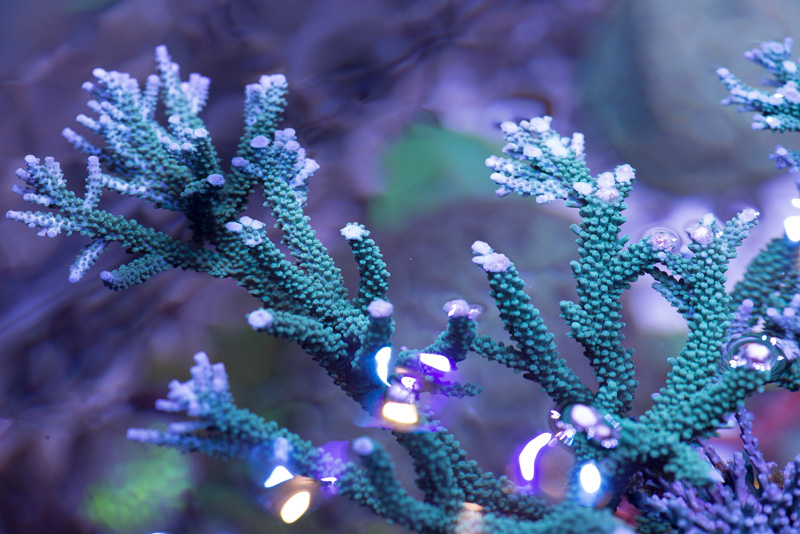 |
• Main Display: 10' x 4' x 3' 900 US-gallon Acrylic Aquarium
• Stand: Steel construction
• Sump: multiple, approximately 500 US-gallons
• Skimmer: RK2 25PE and two Barr 5220's
• Water Pump: PanWorld 250's
• Water Circulation: Iwaki 3 HP 220v pumps running 2 closed loops with 24 eductors in rock work, 2 Tunze waveboxes
• Lighting: AquaIllumination Sol Blues (x13)
• Computer: Apex
• Temperature: Mini Split AC/Heat units, 3x300W heaters, 1.5 HP chiller
• Backup Generator: 15,000 KW
I’m a long time SCUBA diver and wanted to build a system consistent with what I’ve seen out on the reefs, so that meant hiding all man made things like pumps, hoses, etc. The aquascape also needed to be natural looking. The back and sides of the tank are black. I wanted the back wall to be invisible so along with the black walls the rear 12” of the tank was also darkened by shading with PVC matt laid on top of the tank, which also provides for less algae growth on the walls, making it easier to maintain. The back 12” is also open behind the rockwork to provide refuge for fish. I recommend to build what excites you, since the vast majority of the time it will be only you looking at it.
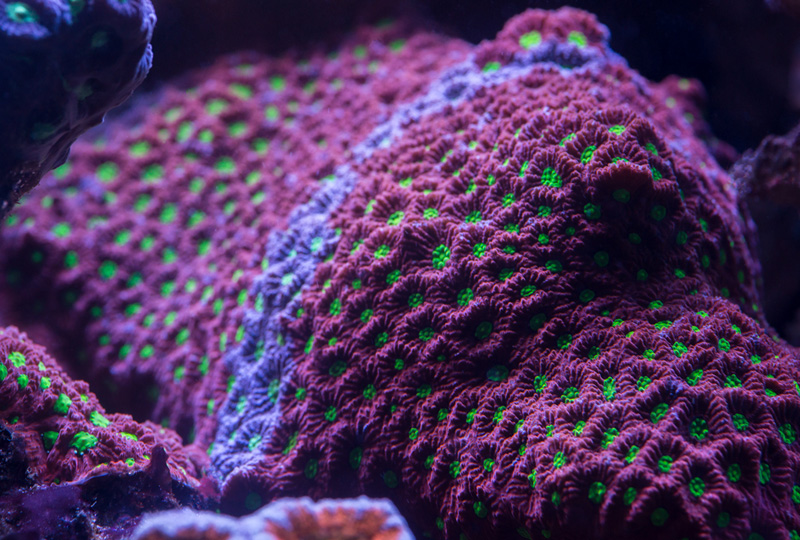 |
The tank and sumps sit in enclosed insulated rooms environmentally controlled by mini split air conditioning/heating units. Although there are tank heaters and a 1.5 hp chiller, they are rarely needed and serve mostly as back up. The temperature varies just one degree year around. With regards to maintaining tank temperature, I have found it’s much easier and more efficient to control the air temperature the tank/sumps sit in, rather than the water directly.
|
Water Parameters:
|
There are two closed loops, each run by a 3 hp Iwaki 220v pump, each controlled by a variable frequency device (VFD), which ramps flow (and electrical draw) up and down. Each closed loop ends in 12 eductors (so the 2 loops together have 24 eductors total) all hidden in the rock work, flowing in patterns that cover the entire bottom of tank in a random manner, to stir up any detritus on the bottom into the water column. Eductors have no moving parts and do not need to be serviced. They also create enormous water movement (they are used in oil and paint vats for mixing) provided they are driven with a pressure rated pump. They pull surrounding water into the eductor, up to 7 times the water being pumped through them. Though the 3 hp Iwaki pumps use a lot of electricity, their use and energy draw are regulated up and down by the VFDs, so their average draw is quite efficient, about a third of their maximum output. There are also 2 Tunze waveboxes producing about a 1” wave. I believe the rocking back and forth from the waveboxes significantly and positively impacts the health of fish and coral.
AI sol blues and I’m very happy with them. There are 13 over the display tank and 2 over the coral QT trays. The intensities have been set at 40% white and 85% blue from the beginning. Each time I’ve tried to increase intensities my coral suffer, so I’ve stopped trying. I believe the difficulties many have had with LEDs are due to excessive intensities, especially with the latest more powerful fixtures. They ramp up for 30 minutes, run for 9 hrs, then ramp down over 30 minutes. There is one fixture over the red carpet anemone that is set at 100% white and 100% blue, and runs about an hour longer then the rest. All fixtures run at 1% blue for moon light until 12 AM, then go off, except for the fixture over the anemone, which stays on 1% all night. This is for the benefit of fish, to see and avoid the carpet anemone at night. I’ve lost one fish to the carpet anemone (that I know of) and that was a wrasse that was dying and swimming sideways that happened to swim right into the anemone. Mother nature took it’s course.
Alkalinity, calcium and magnesium are dosed from 50g reservoirs, each last about 6 months before refilling. I prefer this method over the use of a calcium reactor, which lacks the ability to adjust calcium and alkalinity separately and in my experience was too difficult to adjust and maintain target levels. However, as a backup, I have a large Geo calcium reactor that is connected but not running. Parameters are: Alk 7-8, Ca 450, Mg 1400, Salinity 1.025, Phosphate 0.1-0.15, Nitrate 0. A word about Phosphate. I’ve killed more coral trying to keep phosphate very low than from any other means. I’ve had much more success with higher levels. I use Magnesion P as it reportedly has an impurity that inhibits Bryopsis growth, and it comes in a 5g bucket in granular form. I run Mg continuously on a slow drip, which has been the only thing for me that has kept Bryopsis in check. Separate dosing of Ca, Alk and Mg has provided good control and stable levels, I use BRS peristaltic pumps regulated by the APEX controller.
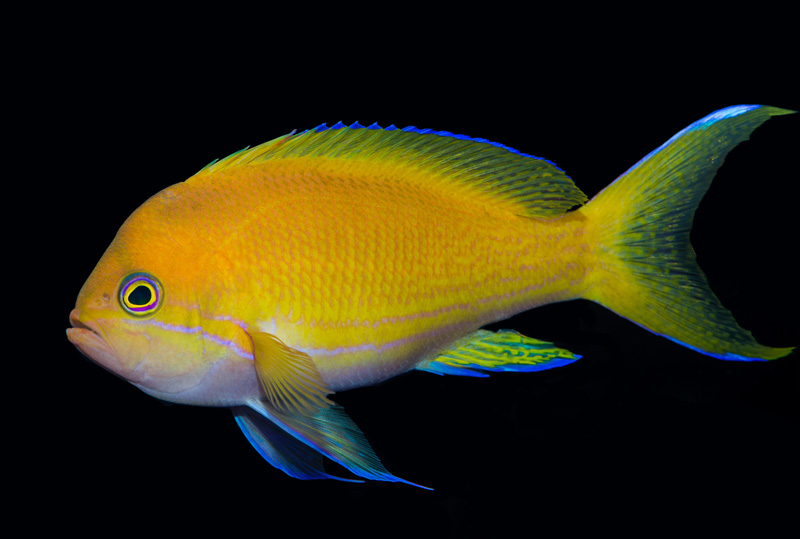 |
I use a method termed “wet skimming” whereby the skimmers are set to produce wet skimmate (more volume), which is then replaced 1:1 with fresh seawater. This results in a continuous water change, exchanging the dirtiest water with the cleanest. It also results in very stable chemistry, avoiding large sudden water changes. I use a large RK2 skimmer and two twin downdraft beckett type Barr 5220 skimmers. A float switch in the sump activates a pump that replenishes the volume loss from the skimmers from a fresh seawater 300g reservoir. There is another 300g RO/DI reservoir that is used for top off and for mixing new seawater. I average about 35% (total volume) water change per month, or about 500 gallons. I have found that many apparently unsolvable problems seem to disappear with more water changes.
Two Santa Monica 100’s. These are well made and work well. I consider their use as another form of nutrient export, as the frequently harvested turf algae binds phosphates and nitrates. I originally built my own and nearly burned my house down on two occasions. Running salt water in close proximity to electricity is hazardous!
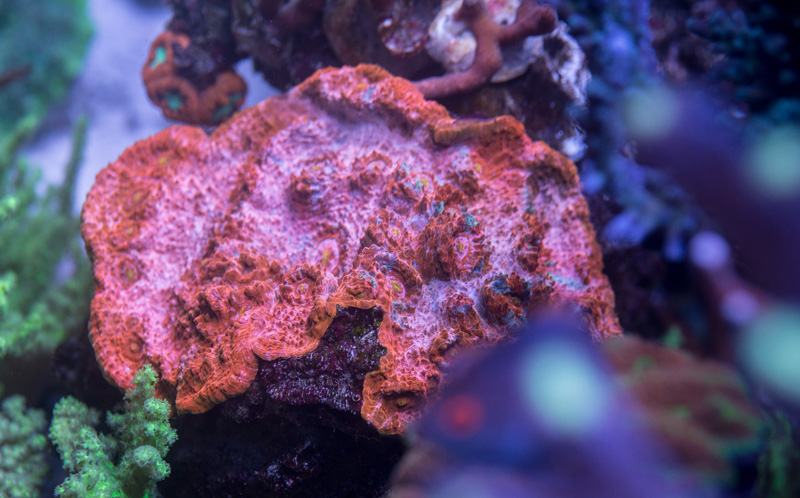 |
One of the sumps has miracle mud. Does it work? I don’t know. I partially remove and add 2 bags per year.
120 W Emperor Aquatics, run only in the early morning hours 4-8 AM each day, theoretically to control disease producing organism populations while not killing too many good critters in the water column with it’s limited use.
Although its heart breaking to lose fish and coral due to stress from QT its much worse allowing disease to enter a reef and possibly losing an entire system. I feel a quarantine is a necessity, especially after establishing a large reef and have more to lose. I have a 150g fish QT in divided cubicles and 180g fish tank QT for larger fish, each are separate systems that run continuously and medicated with Chloroquine Phosphate. Floating and submerged trays are in the 180g QT and serve as the coral QT trays, with AI sol blue lighting at the same settings as the display tank. The trays are fed from display tank water via a peristaltic pump, then the trays overflow into a hose connected to a sink drain. This design serves several purposes:
1. Continuous water change in the trays and because the they are fed from the display tank that is replenished by a seawater reservoir, serve as water change in the display as well
2. Chemistry in the trays is identical to display, making eventual acclimation to display easy
3. Isolation of new coral are placed in separate trays
4. Ease of cleaning a relatively small water volume in the trays
5. Temperature is maintained by the 180g tank they are submerged in.
I dip all SPS in “Bayer Advanced Complete Insect Killer” and transfer to a new tray every 5-6 days for 3 cycles and inspect for pests under magnification, before transferring to the DT. So far, I have avoided AEFW. Most fish go through a minimum of 30 days treatment with Chloroquin Phosphate before transferring to the DT. Fish are treated for specific disease if noted. So far, I have avoided any significant fish disease in the DT.
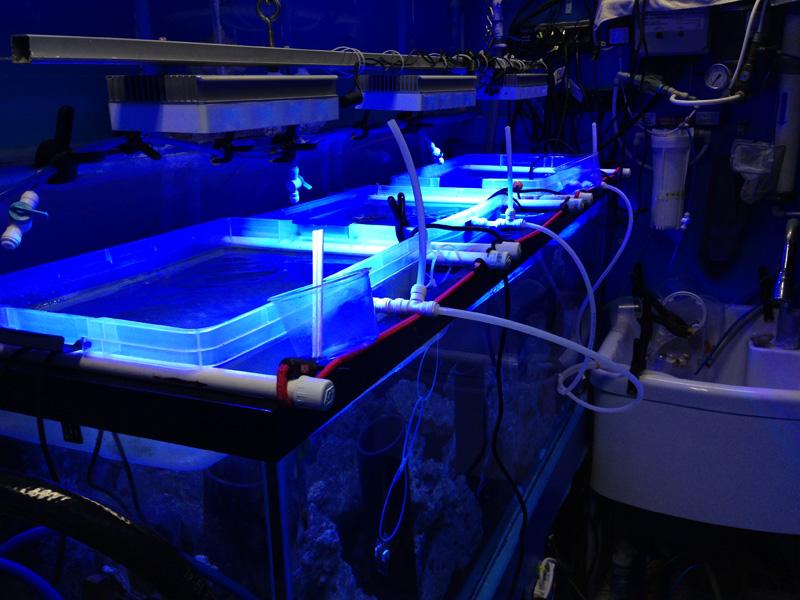 |
I automated as much of the routine jobs as could be done, leaving more time to enjoy the hobby. The system uses an Apex controller that controls the display tank and both QT systems. Some of the built in automation:
• The beckett injectors and massei injector on the skimmers get salt creep which impedes their performance. So there is a RO/DI reservoir that keeps itself full (auto top off from a Spectrapure RO/DI unit) and gravity feeds water into the injectors 3 times a week to clean them, keeping the skimmers working at peak performance.
• Automatic continuous water changes: as skimmate goes down the sink drain it is replaced 1:1 with fresh seawater from a 300g reservoir via a top off float switch in the sump.
• If the skimmers go nuts and remove too much volume they are shut down by level sensors in the sump
• If water temperature reaches 80.1 the skimmer pumps are switched off until temperature falls to 79, then each pump starts sequentially, not at the same time.
• There are flow pumps in all sumps that turn on several times a day for 10 minutes to keep detritus from settling.
• There are series of LED lights at overflows in the sumps to theoretically attract pods and move them to the display tank
• DIY Autofeeder provides frozen and liquid foods that can sustain the tank for 1 month in my absence, during feedings the skimmer pumps are switched off for a few hours.
• All the other great automation that comes with the Apex controller: alerts, turning things on/off under certain conditions, etc.
Refrigerator/freezer: The freezer section is fitted with a rotating tray driven by a pool timer electric motor, controlled by the APEX controller, that drops frozen foods down a pipe into a small sump located in the refrigerator section. There are also bottles of coral liquid foods and amino acids in the refrigerator that are periodically pumped into that sump. The sump then flows to the DT return pump. The auto feeder can maintain the display tank for one month in my absence.
 |
(x2) Barr 5220 twin beckett downdraft (x1) RK2 25PE. I found a quick and easy way to clean them. I temporarily re-route the skimmer exhaust plumbing to the sink drain, then take a garden hose and run it down the skimmer. Cleans up in a matter of minutes, then turn skimmer on briefly to flush with tank water and re-establish exhaust plumbing back to the sump. No need to dismantle the skimmer at all.
BRS regular grade in a reactor, I add a small amount to the reactor every 10 days until the reactor is full, which takes about 8 weeks, then I clean the reactor and start over. I have found adding small amounts of GFO over time provides more stable phosphate levels.
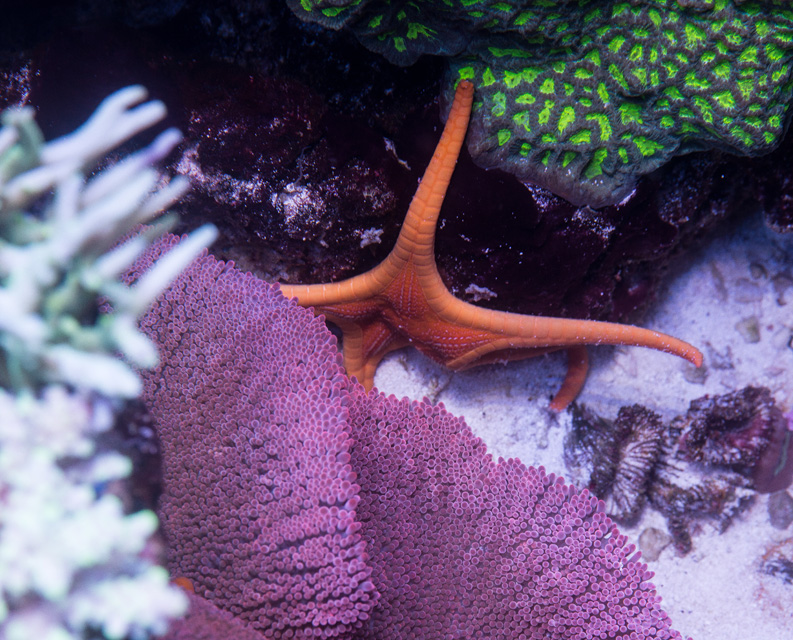 |
BRS rox high grade, hung in an overflow of the dispay tank, in a woman’s leg stocking . I run it for 3 weeks, then remove for a week and start over.
• I never change GFO and Carbon on the same day to avoid stress on livestock.
There is approximately 1400 lbs of lit rock in the display and another 400 lbs of non lit rock in the sumps.
I run a large 12” x 12” polyfilter continuously in a sump, and change it out with a new one every 3 months. I feel it’s so easy for toxicities to find their way into the water, so this provides a possible mechanism of removal. Examining the color after removal can also reveal the type of toxicities and uncover a problem.
I utilize a pneumatic system to remove scratches from the acrylic viewing panel. The compressor motor is filled with organic olive oil instead of regular oil for safety of tank inhabitants. I have had no issues so far using the system.
I feed both coral and fish, so different sized foods are important. I use a variety of foods but mostly Cyclo-Peeze, Hikari frozen mysis, frozen Plankton, fish eggs, ¾ sheet of Nori per day, and Rod’s frozen food. I do not rinse frozen food. Feedings are twice per day. In addition, three times per week the tank is fed Reef Nutrition: Phyto-feast, Roti-feast and Oyster-feast. I also dose Two Little Fishes Acropower daily during the photoperiod.
There are two units: Spectrapure unit for skimmer injectors and backup, and a commercial unit that produces up to 1000g per day, with cylinders for carbon and resin, that runs to a sterilizer and filter before ending in, and automatically filling, a 300g reservoir.
I aimed to simplify and scheduled the routine manual tasks using the Apple calendar to automatically send me phone messages for each task. Tasks include cleaning the front viewing panel every few days, checking Alk, Ca, Mg and SG weekly, adding GFO every 10 days, changing carbon every 3 weeks then one week off, ATS cleaning every month, refilling refrigerator auto feeding trays and reservoirs every month, changing out the polyfilter every 3 months, topping off Mg, Alk and Ca reservoirs every 6 months and changing the UV bulb and Miracle mud every year. Of course there is always something to do on a daily basis like picking up a fallen coral, relocating a stung coral, inspecting everything, etc.
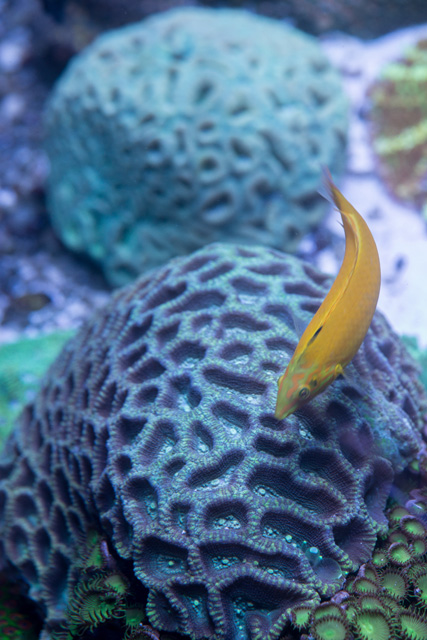 |
• I usually don’t experiment with new products.
• If something is working, I stick with it, and vice versa.
• I try to make changes one at a time and gradually, to understand it’s effect
• Automate as much as possible to achieve stability and leaving more time to enjoy the hobby.
• Realize it’s a dynamic system that is constantly changing, so there is always opportunity for improvement, even when things are not going well.
• When a problem arises I generally don’t react quickly. I have compounded problems by not taking the time to understand them.
• I keep it fun, for me that’s the beauty of the hobby, I love cruising the LFS’s and finding things that I can incorporate into my reef.
• Keep the peace: I try to avoid livestock that is overly aggressive or that will disturb the balance, forcing fish to hide.
• I purchase livestock that is appealing to me, not because it’s rare or has public appeal.
• I generally don’t start projects late in the day. Many things take much longer than planned and I tend to be in a rush as the day goes on and make mistakes.
• Get involved in your local reefing community, it makes the hobby much more enjoyable. I wish we all traded coral without charge, this would create a better establishment of each coral in captivity and makes us focus more on husbandry rather than the expense.
• Eastern philosophy teaches us that happiness can only be achieved through our problems. Our problems are our blessings in disguise. Maybe that’s why I enjoy this hobby so much.
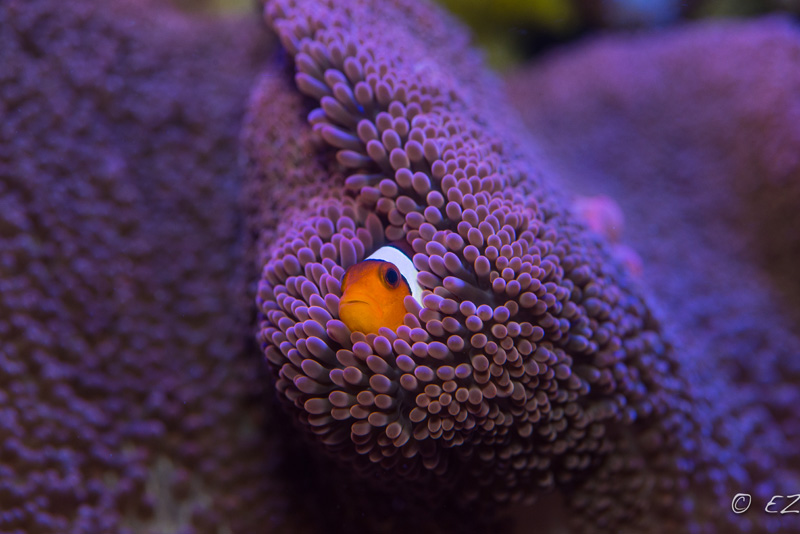 |
Fish
When possible I try to buy bonded pairs. Not surprisingly they generally do better.
Bonded Pairs:
Flame wrasses
Heniochus diphreutis
Lineatus wrasses
Orange spot file fish
Hooded coral sea wrasses
Clownfish
Other fish:
Red tail tamarin wrasse
Yellow tail tamarin wrasse
Yellow corris wrasses x3
Splendid leopard wrasses x2
Ornate leopard wrasses x2
Chaoti wrasse
Melanarus wrasse
Black leopard wrasse
Lyrtail anthias x2
Bartlet anthias x2
Yellow tangs x4
XL Deucimer tang
XL Blonde Naso tang
Naso tang
Yellow Eye Kole tang (can be a bully)
Maculiceps tang
LG Tiger goby
Square spot anthias
Yellow mimic tang
Fire fish x4
Potters wrasse x3
Invertebrates
Red Carpet Anemone: interesting story. So when I showed up at the distributor to pick it up we noticed there were two clown fish inside. The anemone was collected directly from the ocean and shipped to the distributor, so they were hosting the same anemone in the ocean! Very cool ☺
Cleaner shrimp x4
Fire shrimp x4
Tiger serpent stars x4
Bristle star
Pink sea slug
Yellow/red very cool starfish that moves all over the tank
Red carpet anemone
I do not have snails as they eventually die and pollute the tank. Serpent stars do a good job as a clean up crew and never bother anything.
Coral
Neon green nephthea grows fast provides great back and forth movement and color
ORA purple stylophora
Red and green montipora digitata
Green slimmer
Red dragon
Red planet
Blue tort acropora
Various colors of candy canes
Various war favia
Various acans
Tubinaria scrolls
LG blue leptoseris
Green leptoseris
Various pavona maldivensis
XL pinnapple favia
Various lobophyllia
Various pectina
ORA green birdsnest grows like a weed
Various pink birdsnests
Various chalices
Various micromusa
Various deep water acros
ORA Hawkins echinata
Montipora stellata
Various symphyllia
Grape juice sps coral
Garf bonsai sps coral
Star burst montipora
Red, green and purple montipora capricornis
Various photosynthetic gorgonians some are 3 ft tall came from Florida keys
Toadstool leather corals
Green star polyps on side walls.
* I am a farmer for our local reef club, so some of the coral belongs to our “FRAG” club.
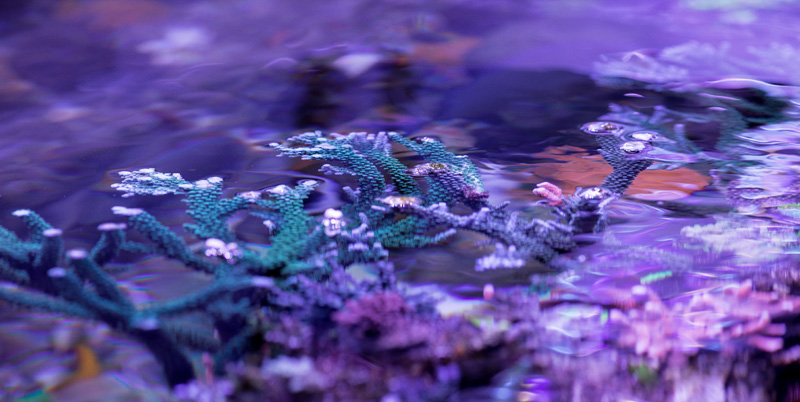 |
Feel free to comment or ask questions about my tank in the Tank of the Month thread on Reef Central.